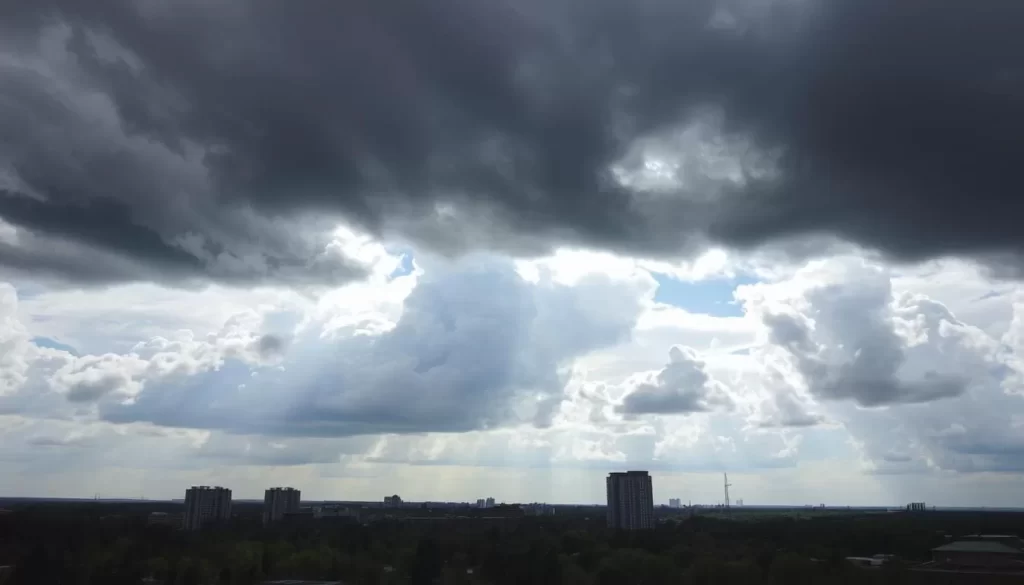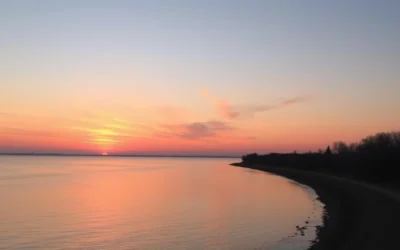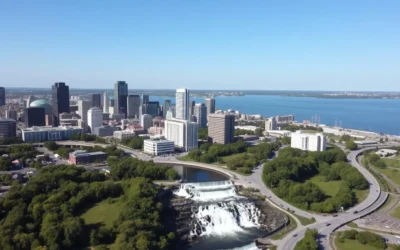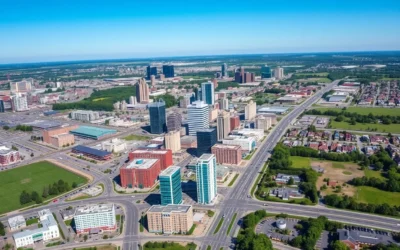✓ Accommodations✓ Flights✓ Rental Cars
Planning a trip involves more than just picking a destination. Understanding the average temperature and seasonal changes can make your experience unforgettable. This guide will help you choose the best time to visit, ensuring you enjoy pleasant weather and avoid unexpected surprises.
Throughout the year, weather patterns shift dramatically, from chilly winters to warm summers. By analyzing temperature trends and seasonal events, you can plan a trip that aligns with your preferences. Whether you prefer mild fall days or sunny summer adventures, this guide has you covered.
Let’s dive into the details and explore how to make the most of your travel plans. With the right information, you’ll be ready to enjoy your trip to the fullest.
Understanding Kitchener’s Unique Weather Patterns
Daily temperature fluctuations play a key role in planning activities. Throughout the day, you might experience warm afternoons and cooler evenings, especially in summer. In winter, mornings can be freezing, while afternoons may feel slightly milder.
Cloud cover and rainfall also influence how the day feels. A sunny day in July can feel much warmer than a cloudy one, even if the temperature is the same. Rainfall can cool things down, making it essential to check forecasts before heading out.
Each month brings its own characteristics. January is known for its crisp, cold days, while July offers long, sunlit afternoons. Understanding these patterns helps you pack appropriately and plan outdoor activities.
Here’s a quick overview of typical daily and monthly temperature shifts:
| Month | Average High (°F) | Average Low (°F) |
|---|---|---|
| January | 28 | 14 |
| April | 54 | 34 |
| July | 81 | 60 |
| October | 59 | 41 |
By understanding these variations, you can make the most of your trip. Whether you’re exploring in summer or winter, knowing what to expect ensures a smoother experience.
Kitchener, Ontario: Best Months for a Weather-Savvy Trip
Timing your visit can make all the difference in your travel experience. The season you choose dramatically impacts your trip, from the activities you enjoy to the overall comfort of your stay.
Weather plays a pivotal role in shaping your adventure. Indicators like moisture, wind, and sunshine all contribute to the quality of your visit. For example, mild weather with moderate rainfall and gentle breezes creates the perfect conditions for outdoor exploration.
Planning your trip during the right time ensures you avoid extreme conditions. Whether it’s avoiding the chill of winter or the heat of summer, choosing a mild season enhances your experience.
Here’s what to consider when planning your visit:
- Focus on months with balanced temperatures and minimal rainfall.
- Look for periods with ample sunshine for outdoor activities.
- Avoid extreme weather patterns like heavy snow or intense heat.
In the following sections, we’ll dive deeper into which months offer the best balance of pleasant weather and exciting opportunities. Stay tuned to make the most of your trip.
Weather Overview: What to Expect in Kitchener’s Seasons
Exploring the seasons in this region reveals a dynamic weather experience. Each season offers unique conditions, from snowy winters to sunny summers. Understanding these patterns helps you plan your visit effectively.
Winter brings heavy snow and chilly temperatures, creating a picturesque landscape. This period is perfect for activities like skiing or cozying up indoors. The crisp air and snow-covered scenery make it a magical time to explore.
Summer, on the other hand, is warm and sunny, ideal for outdoor adventures. Gentle breezes and long daylight hours make it a great time for hiking, biking, or enjoying local parks. The pleasant weather encourages an active lifestyle.
Spring and fall offer a balance between the extremes. Mild temperatures and moderate rainfall create comfortable conditions for exploring. These transitional seasons are perfect for those who enjoy varied weather without the intensity of summer or winter.
Each season has its own appeal, whether you’re drawn to the snowy charm of winter or the vibrant energy of summer. By understanding these patterns, you can choose the best time for your preferred activity and make the most of your trip.
Exploring Seasonal Changes Through Data Analysis
Analyzing seasonal data helps you pinpoint the ideal travel window. By examining monthly trends, you can make informed decisions about when to plan your trip. This approach ensures you avoid extreme weather and enjoy comfortable conditions.
Monthly Temperature Trends
Temperature patterns shift significantly throughout the year. For instance, spring brings gradual warming, with average highs rising from 54°F in April to 81°F in July. This steady increase makes it a great time to visit, especially if you prefer mild weather.
Summer peaks in warmth, while fall sees a gradual decline. Understanding these trends helps you pack appropriately and plan activities that align with the season.
Precipitation and Snowfall Patterns
Rainfall and snowfall also play a crucial role in travel planning. Spring typically sees moderate rainfall, while winter brings heavy snowfall. These patterns influence outdoor activities and overall comfort during your visit.
For example, if you’re planning a trip during spring, you’ll likely encounter fewer disruptions compared to winter. This makes it an excellent time to explore outdoor attractions.
Here’s a quick overview of seasonal precipitation:
- Spring: Moderate rainfall, ideal for outdoor exploration.
- Summer: Occasional showers, balanced with sunny days.
- Fall: Light rainfall, perfect for scenic drives.
- Winter: Heavy snowfall, great for winter sports.
By understanding these patterns, you can choose the best time to visit and make the most of your trip.
Best Time to Visit Kitchener for Outdoor Adventures
Choosing the right season can transform your outdoor adventures. Whether you love warm, sunny days or snowy landscapes, timing your visit ensures you make the most of your trip. Let’s explore the best times for outdoor fun and how the area adapts to seasonal changes.
Top Outdoor Activities in Warm Weather
Summer is the peak season for outdoor enthusiasts. Warm weather and long daylight hours create the perfect conditions for hiking, biking, and exploring local parks. Festivals and public events also thrive during this time, offering plenty of opportunities to connect with the community.
If you’re visiting in July, you’ll find average highs around 81°F, ideal for outdoor adventures. Whether you’re attending a festival or enjoying a scenic hike, the pleasant weather makes every activity more enjoyable.
Embracing Winter Attractions
Winter brings its own charm, especially for those who love snowy landscapes. Activities like ice skating and skiing are popular, offering a unique way to enjoy the season. Cozy indoor events, such as local markets or cultural celebrations, also provide warmth and entertainment.
February is the coldest month, with average temperatures around 27°F. Despite the chill, it’s a great time to experience winter sports or enjoy the festive atmosphere of seasonal events.
No matter the season, the area transforms to offer something special. By matching your interests to the right time of year, you can create unforgettable outdoor adventures.
Kitchener Weather by Month: In-Depth Breakdown
Understanding monthly weather patterns can help you plan a trip that aligns with your preferences. Each month brings unique conditions, from crisp winter mornings to warm summer afternoons. By analyzing temperature and rainfall data, you can choose the ideal time for your visit.

Average Temperature and Rainfall Data
Monthly weather trends show significant variations. For example, January averages a high of 28°F and a low of 14°F, while July sees highs around 81°F and lows near 60°F. Rainfall also fluctuates, with fall often experiencing moderate showers compared to summer’s occasional downpours.
Here’s a detailed breakdown of monthly averages:
| Month | Average High (°F) | Average Low (°F) | Rainfall (inches) |
|---|---|---|---|
| January | 28 | 14 | 2.5 |
| April | 54 | 34 | 3.2 |
| July | 81 | 60 | 3.8 |
| October | 59 | 41 | 3.5 |
Navigating Seasonal Variations
Seasonal changes bring both beauty and challenges. Fall is known for its vibrant foliage and moderate rainfall, making it a picturesque time to explore. However, increased water levels in rivers and lakes can affect outdoor activities.
In contrast, summer offers warm, sunny days ideal for hiking or enjoying local parks. Rainfall during this season is often brief, allowing for uninterrupted outdoor fun.
Understanding these patterns helps you prepare for your trip. Whether you’re visiting in fall or summer, knowing what to expect ensures a smoother experience.
Comparing Kitchener’s Climate with the Rest of Ontario
When planning your next getaway, understanding how a city’s climate compares to its neighbors can shape your experience. Kitchener’s weather patterns offer a unique blend of urban charm and natural beauty, setting it apart from other major cities in the region.
For instance, while Toronto experiences slightly milder winters, Kitchener’s snowy landscapes create a picturesque setting for winter activities. Similarly, Ottawa’s colder temperatures contrast with Kitchener’s more moderate climate, making it a comfortable choice for travel year-round.
Here’s a quick comparison of Kitchener’s climate with other major cities in Ontario:
| City | Average Winter Low (°F) | Average Summer High (°F) | Annual Rainfall (inches) |
|---|---|---|---|
| Kitchener | 14 | 81 | 35 |
| Toronto | 20 | 79 | 32 |
| Ottawa | 10 | 80 | 37 |
What makes Kitchener stand out is its vibrant energy and balance of seasons. Unlike larger cities, it offers a more relaxed pace while still providing plenty of activities and events. Whether you’re exploring its parks in summer or enjoying its winter festivals, the city has something for everyone.
Understanding these differences helps you choose the right destination for your travel plans. Kitchener’s unique climate and urban vibe make it a standout choice for those seeking a memorable experience.
Strategic Trip Planning with Seasonal Scoring
Making the most of your travel plans starts with understanding seasonal scoring systems. These scores, derived from detailed analysis of weather patterns, help you identify the perfect travel window. By evaluating factors like temperature, cloud cover, and precipitation, you can make informed decisions for your trip.
Understanding the Tourism Score
The tourism score is a comprehensive metric that evaluates the best times to visit based on weather conditions. It considers factors like average temperatures, rainfall, and cloud cover to determine ideal travel periods. For example, months with balanced temperatures and minimal rainfall often score higher, making them perfect for outdoor activities.
This score is particularly useful for planning trips during transitional seasons like spring and fall. By focusing on high-scoring months, you can avoid extreme weather and enjoy comfortable conditions for exploring.
Beach/Pool Score for Optimal Enjoyment
If you’re planning a trip focused on water activities, the beach/pool score is your go-to metric. This score highlights periods with clear skies and warm temperatures, such as late June to early September. These months are ideal for swimming, sunbathing, and other water-based fun.
Here’s a quick breakdown of how the beach/pool score is calculated:
| Metric | Weight |
|---|---|
| Temperature | 40% |
| Cloud Cover | 30% |
| Precipitation | 30% |
Using these scores empowers you to plan your trip strategically. Whether you’re aiming for a relaxing beach vacation or an adventurous outdoor getaway, these metrics ensure you pick the best time for your preferred activities.
Discovering Seasonal Events and Local Festivals
Seasonal events bring life and energy to any destination. They offer a chance to experience local culture, connect with communities, and create unforgettable memories. Whether you’re visiting in summer or winter, there’s always something exciting happening.

From vibrant summer festivals to cozy winter celebrations, these events showcase the unique spirit of the region. Timing your visit around these occasions can make your trip even more special. Let’s explore the must-attend events that draw tourists year-round.
Must-Attend Summer and Fall Festivals
Summer and fall are packed with events that celebrate the season’s best. The Kitchener-Waterloo Oktoberfest, running from September 25 to October 12, is a highlight. It’s the largest Oktoberfest in North America, featuring family-friendly activities and cultural showcases.
Another standout is the Niagara Grape & Wine Festival, which spans six days in September. This event combines wine tasting with live concerts, offering a perfect blend of flavors and entertainment. These festivals are a chance to immerse yourself in local traditions and enjoy the vibrant atmosphere.
Winter and Spring Cultural Celebrations
Winter and spring bring their own unique charm. The Niagara Falls’ Winter Festival of Lights is a must-see, featuring over three million lights along a five-kilometer route. This event transforms the area into a magical wonderland, perfect for families and couples alike.
Spring events like the Winterlude festival attract over 650,000 attendees each year. It’s a celebration of winter’s end, with activities ranging from ice sculpting to outdoor concerts. These celebrations highlight the transition between seasons and offer something for everyone.
Planning your visit around these events ensures you experience the best of what the region has to offer. Whether you’re a tourist or a local, these festivals provide a chance to celebrate the seasons in style.
Insider Packing Tips for Every Season
Packing smartly can make or break your travel experience. Each season brings unique weather challenges, and being prepared ensures you stay comfortable. Whether you’re facing heavy snowfall or light, breezy summer days, these tips will help you pack like a pro.
For spring, unpredictable showers are common. Pack a waterproof jacket and layers to adapt to changing temperatures. A sturdy pair of walking shoes is essential for exploring during this part of the year.
In summer, light clothing is your best friend. Opt for breathable fabrics like cotton and linen. Don’t forget sunscreen, a wide-brimmed hat, and sunglasses to protect yourself from the sun.
Fall brings cooler evenings, so layering is key. Bring a mix of long-sleeve shirts, sweaters, and a medium-weight jacket. This part of the year is perfect for scarves and gloves for added warmth.
Winter demands heavy-duty gear. A warm coat, thermal layers, and waterproof boots are essential. Accessories like hats, gloves, and scarves will keep you cozy during snowy days.
For trips between May and September, focus on versatility. Pack items that can be layered or worn alone to handle temperature shifts. This approach ensures you’re ready for any weather.
By tailoring your packing list to the season, you’ll be fully prepared for your trip. For more travel hacks, check out our detailed guides. Happy packing!
Travel Planning: Accommodations and Booking Advice
Finding the right place to stay can significantly enhance your travel experience. Whether you’re planning a weekend getaway or a longer trip, understanding seasonal trends and booking strategies ensures you get the best value and comfort.
Booking Strategies During Peak Seasons
Peak travel months often mean higher demand and prices. To secure the best deals, start your search early. Apps like Hopper and Google Flights can help you track price drops and book at the right time.
Consider flexible dates if possible. Shifting your trip by a few days can save you money and open up more options. This approach is especially useful during popular events or holidays.
Budget-Friendly Accommodation Tips
Traveling during off-peak months can lead to significant savings. Throughout the year, you’ll find better rates and fewer crowds. Look for local rental properties or shared economy options like cottages and vacation homes.
Planning your stay around outdoor activity availability can also help. For example, booking near parks or trails ensures you’re close to the action. This strategy works well for both summer and winter adventures.
For more romantic travel ideas, check out these winter date ideas. They’re perfect for couples looking to make the most of their trip.
Impact of Wind, Clouds, and Precipitation on Your Trip
Weather elements like wind, clouds, and precipitation play a crucial role in shaping your travel experience. Understanding these factors helps you plan better and avoid unexpected disruptions. Whether you’re exploring outdoor attractions or attending local events, being prepared ensures a smoother trip.
Wind patterns can significantly affect your daily activities. For instance, strong gusts might make hiking or biking challenging, especially in open areas. On the other hand, gentle breezes can enhance your experience by keeping you cool during warm days.

Cloud cover also influences how the day feels. A sunny day in June early September can feel warmer than a cloudy one, even if the temperature is the same. Checking forecasts helps you plan outdoor activities accordingly.
Precipitation, whether rain or snow, can impact your travel plans. During the season kitchener, moderate rainfall is common, making waterproof gear essential. Heavy snowfall in winter might limit outdoor activities but opens up opportunities for winter sports.
Here’s a quick overview of typical weather conditions during key periods:
| Period | Wind Speed (mph) | Cloud Cover (%) | Precipitation (inches) |
|---|---|---|---|
| June Early September | 8-12 | 40-60 | 3.5 |
| Fall Transition | 10-15 | 50-70 | 4.0 |
Planning your visit kitchener around these factors ensures a comfortable and enjoyable trip. For more insights on climate adaptation strategies, explore our detailed resources. Happy travels!
Enjoying Water Activities: Kitchener’s Nearby Attractions
Summer in this region offers a perfect blend of warm weather and refreshing water activities. The water conditions during this season are ideal for swimming, kayaking, and other fun-filled adventures. With temperatures often reaching their peak, it’s the best time to dive into nearby lakes or enjoy pool events.
The duration of warm water periods is measured in hours, ensuring you have plenty of time to enjoy the outdoors. These extended periods of warmth make local attractions even more appealing. Whether you’re lounging by the pool or exploring a nearby lake, the weather plays a key role in enhancing your experience.
Summer Water Conditions and Pool Events
During the summer months, water temperatures are at their most inviting. This makes it the perfect time for activities like swimming, paddleboarding, and even water festivals. Local pools and lakes often host events that draw both residents and visitors, creating a vibrant atmosphere.
Clear skies and minimal precipitation further enhance these activities. Dry weather ensures that your plans aren’t interrupted, allowing you to make the most of your time outdoors. It’s no wonder that water activities are a highlight of the summer season.
From family-friendly pool parties to serene lakeside picnics, there’s something for everyone. These experiences not only provide entertainment but also create lasting memories.
Embracing water activities is a key part of the overall summer experience. Whether you’re a local or a visitor, these attractions offer a chance to relax, have fun, and connect with nature. So, pack your swimsuit and get ready to dive into the season’s best offerings!
Maximizing Your Trip with Weather Data Insights
Using weather data insights can elevate your travel experience by aligning your plans with optimal conditions. By analyzing factors like temperature, cloud cover, and precipitation, you can make informed decisions that enhance your trip.
Aligning your visit with specific festival dates and local events ensures you don’t miss out on unique experiences. For example, the late June early period often features vibrant celebrations and outdoor activities. These moments are perfect for immersing yourself in local culture and enjoying the season’s highlights.
Weather elements like cloud cover and rainfall play a significant role in shaping your daily plans. A sunny day can make outdoor events more enjoyable, while rain might shift your focus to indoor attractions. Checking forecasts helps you adapt and make the most of your time.
Here’s how to use weather data to plan effectively:
- Check average temperatures and rainfall for your travel dates.
- Align your visit with key festival periods for added excitement.
- Prepare for weather shifts by packing versatile clothing.
By leveraging these insights, you can create a travel plan that balances comfort and adventure. Whether you’re exploring local events or enjoying seasonal highlights, weather data ensures a smoother, more enjoyable trip.
Adjusting Your Travel Plans: Pros and Cons for Each Season
Each season brings unique challenges and opportunities for travelers. Understanding the pros and cons of each period helps you make informed decisions and enjoy your trip to the fullest. Whether you’re planning a summer getaway or a winter retreat, knowing what to expect ensures a smoother experience.

Spring offers mild temperatures and blooming landscapes, making it a perfect time for outdoor exploration. However, unpredictable rain showers can disrupt plans, so packing waterproof gear is essential. The variation in weather during this season requires flexibility, but the rewards are worth it.
In summer, warm weather and long days create ideal conditions for outdoor activities. However, occasional heatwaves and increased tourist crowds can be drawbacks. Planning ahead ensures you avoid peak times and enjoy the season’s highlights.
Fall brings cooler temperatures and vibrant foliage, making it a favorite for many travelers. The wind can be brisk, but it adds to the charm of the season. This is a great time for scenic drives and outdoor festivals, though shorter daylight hours may limit your activities.
Winter offers snowy landscapes and cozy indoor events, perfect for those who enjoy the cold. However, heavy snowfall and freezing temperatures can make travel challenging. Preparing for these conditions ensures you stay comfortable and safe.
Seasonal transitions, like the shift from summer to fall, may require adjustments to your plans. Being aware of these changes helps you adapt and make the most of your trip. For example, preparing your vehicle for seasonal vehicle maintenance ensures a smoother journey during unpredictable weather.
By weighing the pros and cons of each season, you can choose the perfect time for your visit. Whether you’re drawn to the warmth of summer or the tranquility of winter, understanding these factors helps you plan a trip that aligns with your preferences.
Conclusion
Your travel experience can be greatly enhanced by understanding seasonal weather patterns. Knowing the average high temperatures and typical conditions helps you plan activities that align with your preferences. Whether you prefer warm summer days or crisp winter mornings, careful planning ensures you make the most of your trip.
Using detailed weather data, you can choose the ideal time to visit. Aligning your plans with periods of optimal conditions, like mild temperatures and minimal rainfall, ensures a comfortable and enjoyable experience. This approach allows you to avoid extreme weather and focus on what you love most.
Start planning your adventure today. With the insights provided, you’re ready to select the perfect time for your visit. Embrace the beauty of each season and create unforgettable memories.
The above is subject to change.
Check back often to TRAVEL.COM for the latest travel tips and deals.






